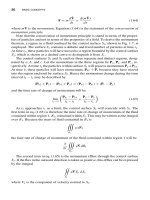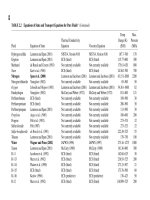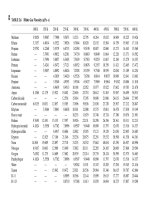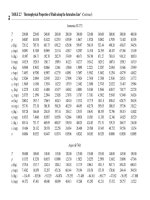Heat Transfer Handbook part 3 potx
Bạn đang xem bản rút gọn của tài liệu. Xem và tải ngay bản đầy đủ của tài liệu tại đây (168.21 KB, 10 trang )
BOOKCOMP, Inc. — John Wiley & Sons / Page 10 / 2nd Proofs / Heat Transfer Handbook / Bejan
10 BASIC CONCEPTS
1
2
3
4
5
6
7
8
9
10
11
12
13
14
15
16
17
18
19
20
21
22
23
24
25
26
27
28
29
30
31
32
33
34
35
36
37
38
39
40
41
42
43
44
45
[10], (10)
Lines: 411 to 465
———
0.10216pt PgVar
———
Normal Page
PgEnds: T
E
X
[10],
(10)
d
e
≡
4A
p
In the inlet zones of such parallel-plate channels and along isolated plates, the heat
transfer coefficient varies with the distance from the leading edge. The low-velocity,
or laminar flow, average convective heat transfer coefficient along a surface of length
L for Re ≤ 3 × 10
5
is found to be
h = 0.664
k
L
Re
1/2
· Pr
1/3
(W/m
2
· K) (1.17)
where k is the fluid thermal conductivity, L the characteristic dimension of the sur-
face, and Re the Reynolds number based on L: namely,
ˆ
VL/ν.
A similar relation applies to a flow in tubes, pipes, annuli or channels, with the
equivalent diameter d
e
serving as the characteristic dimension in both the Nusselt
and Reynolds numbers. For laminar flow, Re ≤ 2100,
hd
e
k
= 1.86
Re · Pr
d
e
L
1/3
µ
µ
w
0.14
(1.18)
which is attributed to Sieder and Tate (1936) and where µ
w
is the viscosity of the
convective medium at the channel wall temperature. Observe that this relationship
shows that the heat transfer coefficient attains its maximum value at the inlet to the
channel and decreases as d
e
/L decreases.
In higher-velocity turbulent flow along plates, the dependence of the convective
heat transfer coefficient on the Reynolds number increases, and in the range Re ≥
3 × 10
5
,
h = 0.036
k
L
Re
0.8
· Pr
1/3
(W/m
2
· K) (1.19)
In pipes, tubes, annuli, and channels, turbulent flow occurs at an equivalent
diameter-based Reynolds number of 10,000, with the regime bracketed by 2100 ≤
Re ≤ 10,000 usually referred to as the transition region. For the transition region,
Hausen (1943) has provided the correlating equation
hd
e
k
= 0.116(Re − 125)Pr
1/3
1 +
d
e
L
2/3
µ
µ
w
0.14
(1.20)
and Sieder and Tate (1936) give for turbulent flow
hd
e
k
= 0.023Re
0.8
· Pr
1/3
µ
µ
w
0.14
(1.21)
Forced convection in internal and external flows is treated in greater detail in Chapters
5 and 6.
BOOKCOMP, Inc. — John Wiley & Sons / Page 11 / 2nd Proofs / Heat Transfer Handbook / Bejan
HEAT TRANSFER FUNDAMENTALS
11
1
2
3
4
5
6
7
8
9
10
11
12
13
14
15
16
17
18
19
20
21
22
23
24
25
26
27
28
29
30
31
32
33
34
35
36
37
38
39
40
41
42
43
44
45
[11], (11)
Lines: 465 to 512
———
-2.68394pt PgVar
———
Normal Page
PgEnds: T
E
X
[11],
(11)
1.1.7 Phase-Change Heat Transfer
Boiling heat transfer displays a complex dependence on the temperature difference
between the heated surface and the saturation temperature (boiling point) of the
liquid. Following Rohsenow (1952), the heat transfer rate in nucleate boiling, the
primary region of interest, can be approximated by a relation of the form
q
φ
= C
sf
A(T
s
− T
sat
)
3
(W) (1.22)
where C
sf
is a function of the surface–fluid combination. For comparison purposes,
it is possible to define a boiling heat transfer coefficient h
φ
:
h
φ
= C
sf
(T
s
− T
sat
)
2
(W/m
2
· K)
which, however, will vary strongly with surface temperature. Boiling and condensa-
tion are treated in greater detail in Chapters 9 and 10, respectively.
1.1.8 Finned Surfaces
Frequent use is made of finned or extended surfaces, and while such finning can
substantially increase the surface area in contact with the coolant, conduction in the
fin reduces the average temperature of the exposed surface relative to the fin base. In
the analysis of such finned surfaces, it is common to define a fin efficiency η as being
equal to the ratio of the actual heat dissipated by the fin to the heat that would be
dissipated if the fin possessed an infinite thermal conductivity. Using this approach,
heat transferred from a fin or a fin structure can be expressed in the form
q
f
= hS
f
η(T
b
− T
s
)(W) (1.23)
where S
f
is the surface area of the fin, T
b
the temperature at the base of the fin, T
s
the surrounding temperature, and q
b
the heat entering the base of the fin, which in
the steady state is equal to the heat dissipated by the fin. The thermal resistance of a
finned surface is given by
R
f
≡
1
hS
f
η
(1.24)
and η is approximately 0.63 for a thermally optimum rectangular-cross-section fin.
1.1.9 Flow Resistance
The transfer of heat to a flowing gas or liquid that is not undergoing a phase change
results in an increase in the coolant temperature from an inlet temperature of T
in
to
an outlet temperature of T
out
, according to
q =˙mc
p
(
T
out
− T
in
)
(W) (1.25)
BOOKCOMP, Inc. — John Wiley & Sons / Page 12 / 2nd Proofs / Heat Transfer Handbook / Bejan
12 BASIC CONCEPTS
1
2
3
4
5
6
7
8
9
10
11
12
13
14
15
16
17
18
19
20
21
22
23
24
25
26
27
28
29
30
31
32
33
34
35
36
37
38
39
40
41
42
43
44
45
[12], (12)
Lines: 512 to 571
———
-0.01393pt PgVar
———
Normal Page
PgEnds: T
E
X
[12],
(12)
Based on this relation, it is possible to define an effective flow resistance, R
fl
,as
R
fl
≡
1
˙mc
p
(K/W) (1.26)
1.1.10 Radiative Heat Transfer
Unlike conduction and convection, radiative heat transfer between two surfaces or
between a surface and its surroundings is not linearly dependent on the temperature
difference and is expressed instead as
q = σA
F
T
4
1
− T
4
2
(W) (1.27)
where
F includes the effects of surface properties and geometry and σ is the Stefan–
Boltzmann constant, σ = 5.669 × 10
−8
W/m
2
· K
4
. For modest temperature differ-
ences, this equation can be linearized to the form
q
r
= h
r
S(T
1
− T
2
)(W) (1.28)
where h
r
is the effective “radiation” heat transfer coefficient,
h
r
= σF
T
2
1
+ T
2
2
(
T
1
+ T
2
)
(W/m
2
· K) (1.29a)
and for small ∆T = T
1
− T
2
is approximately equal to
h
r
= 4σF
(
T
1
T
2
)
3/2
(W/m
2
· K) (1.29b)
It is of interest to note that for temperature differences on the order of 10 K, the
radiative heat transfer coefficient h
r
for an ideal (or “black”) surface in an absorbing
environment is approximately equal to the heat transfer coefficient in natural convec-
tion of air. Noting the form of eq. (1.27), the radiation thermal resistance, analogous
to the convective resistance, is seen to equal
R
r
≡
1
h
r
S
(K/W) (1.30)
1.2 COORDINATE SYSTEMS
Heat transfer and fluid flow analyses of objects of various sizes and shapes and
their corresponding flow fields are facilitated by working in a coordinate system
that provides a good fit to the flow geometry. Figure 1.5 presents diagrams for the
rectangular (Cartesian), cylindrical, and spherical coordinate systems. Equations for
the gradient of a scalar, divergence and curl of a vector, and the Laplacian are given
below for the three coordinate systems.
BOOKCOMP, Inc. — John Wiley & Sons / Page 13 / 2nd Proofs / Heat Transfer Handbook / Bejan
COORDINATE SYSTEMS
13
1
2
3
4
5
6
7
8
9
10
11
12
13
14
15
16
17
18
19
20
21
22
23
24
25
26
27
28
29
30
31
32
33
34
35
36
37
38
39
40
41
42
43
44
45
[13], (13)
Lines: 571 to 571
———
-17.073pt PgVar
———
Normal Page
PgEnds: T
E
X
[13],
(13)
r
= 0
z=0
= 0
= 0
r
y
ˆ
V
y
ˆ
V
x
ˆ
V
z
ˆ
V
z
ˆ
V
r
ˆ
V
r
ˆ
V
θ
ˆ
V
θ
ˆ
V
φ
x
z
Origin
Figure 1.5 Rectangular (Cartesian), cylindrical, and spherical coordinate systems.
BOOKCOMP, Inc. — John Wiley & Sons / Page 14 / 2nd Proofs / Heat Transfer Handbook / Bejan
14 BASIC CONCEPTS
1
2
3
4
5
6
7
8
9
10
11
12
13
14
15
16
17
18
19
20
21
22
23
24
25
26
27
28
29
30
31
32
33
34
35
36
37
38
39
40
41
42
43
44
45
[14], (14)
Lines: 571 to 642
———
5.44533pt PgVar
———
Normal Page
* PgEnds: Eject
[14],
(14)
1.2.1 Rectangular (Cartesian) Coordinate System
For a rectangular coordinate system with coordinates x, y, and z and unit vectors e
x
,
e
y
, and e
z
, the gradient of the scalar T is
grad T =∇T = e
x
∂T
∂x
+ e
y
∂T
∂y
+ e
z
∂T
∂z
(1.31)
The divergence of a vector V having components V
x
,V
y
, and V
z
is
div V =∇·V =
∂V
x
∂x
+
∂V
y
∂y
+
∂V
z
∂z
(1.32)
The curl of the vector V is
curl V =∇× V = e
x
∂V
z
∂y
−
∂V
y
∂z
+ e
y
∂V
x
∂z
−
∂V
z
∂x
+ e
z
∂V
y
∂x
−
∂V
x
∂y
(1.33)
Alternatively, curl V may be written as the determinant
e
x
e
y
e
z
∂
∂x
∂
∂y
∂
∂z
V
x
V
y
V
z
(1.34)
The Laplacian of the scalar T is
∇
2
T =
∂
2
T
∂x
2
+
∂
2
T
∂y
2
+
∂
2
T
∂z
2
(1.35)
1.2.2 Cylindrical Coordinate System
For a cylindrical coordinate system with coordinates r, θ, and z and unit vectors e
r
,
e
θ
, and e
z
, the gradient of the scalar T is
grad T =∇T = e
r
∂T
∂r
+ e
θ
1
r
∂T
∂θ
+ e
z
∂T
∂z
(1.36)
The divergence of a vector V having components, V
r
,V
θ
, and V
z
is
div V =∇·V =
1
r
∂(rV
r
)
∂r
+
1
r
∂V
θ
∂θ
+
∂V
z
∂z
(1.37)
BOOKCOMP, Inc. — John Wiley & Sons / Page 15 / 2nd Proofs / Heat Transfer Handbook / Bejan
COORDINATE SYSTEMS
15
1
2
3
4
5
6
7
8
9
10
11
12
13
14
15
16
17
18
19
20
21
22
23
24
25
26
27
28
29
30
31
32
33
34
35
36
37
38
39
40
41
42
43
44
45
[15], (15)
Lines: 642 to 712
———
6.53831pt PgVar
———
Normal Page
* PgEnds: Eject
[15],
(15)
The curl of the vector V is
curl V =∇×V = e
r
1
r
∂V
z
∂θ
−
∂V
θ
∂z
+ e
θ
∂V
r
∂z
−
∂V
z
∂r
+ e
z
1
r
∂(rV
θ
)
∂r
−
∂V
r
∂θ
(1.38)
Alternatively, curl V may be written as the determinant
e
r
1
r
e
θ
e
z
1
r
∂
∂r
∂
∂θ
∂
∂z
V
r
rV
θ
V
z
(1.39)
The Laplacian of the scalar T is
∇
2
T =
1
r
∂
∂r
r∂T
∂r
+
1
r
2
∂
2
T
∂θ
2
+
∂
2
T
∂z
2
(1.40)
1.2.3 Spherical Coordinate System
For a spherical coordinate system with coordinates r, θ, and φ and unit vectors e
r
, e
θ
,
and e
φ
, the gradient of the scalar T is
grad T =∇T = e
r
∂T
∂r
+ e
φ
1
r
∂T
∂φ
+ e
θ
1
r sin φ
∂T
∂θ
(1.41)
The divergence of a vector V having components, V
r
, V
θ
, and V
φ
is
div V =∇·V =
1
r
2
∂(r
2
V
r
)
∂r
+
1
r sin φ
∂(V
φ
sin φ)
∂φ
+
1
r sin φ
∂V
θ
∂θ
(1.42)
The curl of the vector V is
curl V =∇×V = e
r
1
r sin φ
∂
(
V
θ
sin φ
)
∂φ
−
∂V
φ
∂θ
+ e
φ
1
r
1
sin φ
∂V
r
∂θ
−
∂
(
rV
θ
)
∂r
+ e
θ
1
r
∂
rV
φ
∂r
−
∂V
r
∂φ
(1.43)
The Laplacian of the scalar T is
∇
2
T =
1
r
2
∂
∂r
r
2
∂T
∂r
+
1
r
2
sin φ
∂
dφ
sin φ
∂T
∂φ
+
1
r
2
sin
2
φ
∂
2
T
∂θ
2
(1.44)
BOOKCOMP, Inc. — John Wiley & Sons / Page 16 / 2nd Proofs / Heat Transfer Handbook / Bejan
16 BASIC CONCEPTS
1
2
3
4
5
6
7
8
9
10
11
12
13
14
15
16
17
18
19
20
21
22
23
24
25
26
27
28
29
30
31
32
33
34
35
36
37
38
39
40
41
42
43
44
45
[16], (16)
Lines: 712 to 766
———
1.97217pt PgVar
———
Normal Page
PgEnds: T
E
X
[16],
(16)
1.2.4 General Curvilinear Coordinates
In general, a curvilinear coordinate system can be proposed where a vector V has
components V
1
,V
2
, and V
3
in the x
1
,x
2
, and x
3
coordinate directions. The unit vectors
are e
1
, e
2
, and e
3
in the coordinate directions x
1
,x
2
, and x
3
and there are scale factors,
s
1
,s
2
, and s
3
that relate the general curvilinear coordinate system to the rectangular,
cylindrical, and spherical coordinate systems.
In the general curvilinear coordinate system, the gradient of a scalar T is
grad T =∇T = e
1
1
s
1
∂T
∂x
1
+ e
2
1
s
2
∂T
∂x
2
+ e
3
1
s
3
∂T
∂x
3
(1.45)
The divergence of a vector V having components, V
1
,V
2
, and V
3
is
div V =∇·V =
1
s
1
s
2
s
3
∂(s
2
s
3
V
1
)
∂x
1
+
∂(s
3
s
1
V
2
)
∂x
2
+
∂(s
1
s
2
V
3
)
∂x
3
(1.46)
The curl of the vector V is
curl V =∇×V = e
1
1
s
2
s
3
∂(s
3
V
3
)
∂x
2
−
∂(s
2
V
2
)
∂x
3
+ e
2
1
s
1
s
3
∂(s
1
V
1
)
∂x
3
−
∂(s
3
V
3
)
∂x
1
+ e
3
1
s
1
s
2
∂(s
2
V
2
)
∂x
1
−
∂(s
1
V
1
)
∂x
2
(1.47)
The Laplacian of the scalar T is
∇
2
T =
1
s
1
s
2
s
3
∂
∂x
1
s
2
s
3
s
1
∂T
∂x
1
+
∂
∂x
2
s
1
s
3
s
2
∂T
∂x
2
+
∂
∂x
3
s
1
s
2
s
3
∂T
∂x
3
(1.48)
In eqs. (1.45) through (1.48), the conversion from the general curvilinear coordi-
nate system to the rectangular, cylindrical, and spherical coordinate systems depends
on the assignment of values to the coordinates x
1
,x
2
, and x
3
and the scale factors
s
1
,s
2
, and s
3
.
x
1
x
2
x
3
s
1
s
2
s
3
Rectangular: xyz11 1
Cylindrical: r θ z 1 r 1
Spherical: r φθ1 rrsin φ
1.3 CONTINUITY EQUATION
A control volume is a region in space selected for analysis. An incremental control
volume carrying a mass flux is shown in Fig. 1.6. The conservation of mass principle
BOOKCOMP, Inc. — John Wiley & Sons / Page 17 / 2nd Proofs / Heat Transfer Handbook / Bejan
CONTINUITY EQUATION
17
1
2
3
4
5
6
7
8
9
10
11
12
13
14
15
16
17
18
19
20
21
22
23
24
25
26
27
28
29
30
31
32
33
34
35
36
37
38
39
40
41
42
43
44
45
[17], (17)
Lines: 766 to 808
———
5.45322pt PgVar
———
Normal Page
PgEnds: T
E
X
[17],
(17)
can be applied to the control volume by noting that the net rate of mass flux out of
the control volume plus the rate of accumulation of mass within the control volume
must equal zero:
A
ρ
ˆ
V · n
dA =
∂
∂t
V
ρ dV (1.49)
Observe that the mass within the control volume is
m = ρ∆x ∆y ∆z
and that the mass flux at each of the faces of Fig. 1.6 will be ρ(
ˆ
V · n), where n is the
normal to the area dA.
Noting that the density can vary from point to point and with time, ρ = f (x,y,z,
t), the net mass flux out of the control volumes in each of the coordinate directions
will be
ρ
ˆ
V
x|x+∆x
− ρ
ˆ
V
x|x
∆y ∆z
ρ
ˆ
V
y|y+∆y
− ρ
ˆ
V
y|y
∆x ∆z
ρ
ˆ
V
z|z+∆z
− ρ
ˆ
V
z|z
∆x ∆y
With all of the foregoing substituted into eq. (1.49),
ρ
ˆ
V
x|x∆x
− ρ
ˆ
V
x|x
∆y ∆z +
ρ
ˆ
V
y|y+∆y
− ρ
ˆ
V
y|y
∆x ∆z
+
ρ
ˆ
V
z|z+∆z
− ρ
ˆ
V
z|z
∆x ∆y +
∂ρ
∂t
∆x ∆y ∆z = 0
Figure 1.6 Mass flux through an incremental flow volume.
BOOKCOMP, Inc. — John Wiley & Sons / Page 18 / 2nd Proofs / Heat Transfer Handbook / Bejan
18 BASIC CONCEPTS
1
2
3
4
5
6
7
8
9
10
11
12
13
14
15
16
17
18
19
20
21
22
23
24
25
26
27
28
29
30
31
32
33
34
35
36
37
38
39
40
41
42
43
44
45
[18], (18)
Lines: 808 to 876
———
3.69627pt PgVar
———
Normal Page
* PgEnds: Eject
[18],
(18)
and after division by ∆z ∆y ∆z, the result is
ρ∂
ˆ
V
x|x+∆x
− ρ
ˆ
V
x|x
∆x
+
ρ
ˆ
V
y|y+∆y
− ρ
ˆ
V
y|y
∆y
+
ρ
ˆ
V
z|z+∆z
− ρ
ˆ
V
z|z
∆z
+
∂ρ
∂t
= 0
In the limit as ∆x, ∆y, and ∆z all tend to zero, the result is
∂
∂x
(ρ
ˆ
V
x
) +
∂
∂y
(ρ
ˆ
V
y
) +
∂
∂z
(ρ
ˆ
V
z
) +
∂ρ
∂t
= 0 (1.50)
This may be written as
∇·ρ
ˆ
V +
∂ρ
∂t
= 0 (1.51)
where ∇·ρ
ˆ
V = div ρ
ˆ
V is the divergence of the vector
ˆ
V. This equation is general: It
applies to unsteady three-dimensional flow with variable ρ.
Equation (1.51) is a vector equation that represents the equation of continuity in
rectangular, cylindrical, and spherical coordinates. If the flow is incompressible, so
that ρ is independent of time, eq. (1.51) reduces to
∇·ρ
ˆ
V = 0 (1.52)
which applies to both steady and unsteady flow. This equation is also a vector equation
that applies to rectangular, cylindrical, and spherical coordinates.
Equation (1.50) can be written as
∂ρ
∂t
+
ˆ
V
x
∂ρ
∂x
+
ˆ
V
y
∂ρ
∂y
+
ˆ
V
z
∂ρ
∂z
+ ρ
∂
ˆ
V
x
∂x
+
∂
ˆ
V
y
∂y
+
∂
ˆ
V
z
∂z
= 0
or
Dρ
Dt
+ ρ∇·
ˆ
V = 0 (1.53)
where
Dρ
Dt
=
∂ρ
∂t
+
ˆ
V
x
∂ρ
∂x
+
ˆ
V
y
∂ρ
∂y
+
ˆ
V
z
∂ρ
∂z
(1.54)
is called the substantial derivative of the density ρ. Thus, in rectangular coordinates,
D
Dt
=
∂
∂t
+
ˆ
V
x
∂
∂x
+
ˆ
V
y
∂
∂y
+
ˆ
V
z
∂
∂z
(1.55)
The substantial derivative in cylindrical coordinates is
BOOKCOMP, Inc. — John Wiley & Sons / Page 19 / 2nd Proofs / Heat Transfer Handbook / Bejan
MOMENTUM AND THE MOMENTUM THEOREM
19
1
2
3
4
5
6
7
8
9
10
11
12
13
14
15
16
17
18
19
20
21
22
23
24
25
26
27
28
29
30
31
32
33
34
35
36
37
38
39
40
41
42
43
44
45
[19], (19)
Lines: 876 to 940
———
9.04248pt PgVar
———
Normal Page
* PgEnds: Eject
[19],
(19)
D
Dt
=
∂
∂t
+
ˆ
V
r
∂
∂r
+
ˆ
V
θ
r
∂
∂
θ
+
ˆ
V
z
∂
∂z
(1.56)
and in spherical coordinates, it is
D
Dt
=
∂
∂t
+
ˆ
V
r
∂
∂r
+
ˆ
V
φ
r
∂
∂φ
+
ˆ
V
θ
r sin φ
∂
∂θ
(1.57)
The equation of continuity representing the conservation of mass can be summa-
rized for the three coordinate systems. For the rectangular coordinate system,
∂ρ
∂t
+
∂(ρ
ˆ
V
x
)
∂x
+
∂(ρ
ˆ
V
y
)
∂y
+
∂(ρ
ˆ
V
z
)
∂z
= 0 (1.58)
for the cylindrical coordinate system,
∂ρ
∂t
+
1
r
∂(ρr
ˆ
V
r
)
∂r
+
1
r
∂(ρ
ˆ
V
θ
)
∂θ
+
∂(ρ
ˆ
V
z
)
∂z
= 0 (1.59)
and for the spherical coordinate system,
∂ρ
∂t
+
1
r
2
∂(ρr
2
ˆ
V
r
)
∂r
+
1
r sin φ
∂(ρ
ˆ
V
φ
sin φ)
∂φ
+
1
r sin φ
∂(ρ
ˆ
V
θ
)
∂θ
= 0 (1.60)
In the event that the flow may be modeled as incompressible,
∂
ˆ
V
x
∂x
+
∂
ˆ
V
y
∂y
+
∂
ˆ
V
z
∂z
= 0 (1.61)
for the cylindrical coordinate system,
1
r
∂(r
ˆ
V
r
)
∂r
+
1
r
∂
ˆ
V
θ
∂θ
+
∂
ˆ
V
z
∂z
= 0 (1.62)
and for the spherical coordinate system,
1
r
2
∂(r
2
ˆ
V
r
)
∂r
+
1
r sin φ
∂(
ˆ
V
φ
sin φ)
∂φ
+
1
r sin φ
∂
ˆ
V
θ
∂θ
= 0 (1.63)
1.4 MOMENTUM AND THE MOMENTUM THEOREM
The momentum theorem of fluid mechanics provides a relation between a group of
field points. It is especially useful when the details of the flow field are more than
moderately complicated and it is based on Newton’s law, which can be written as









